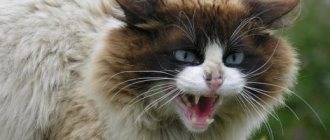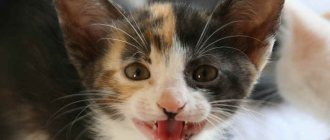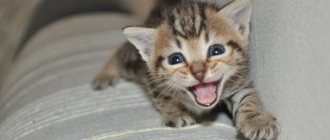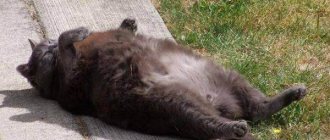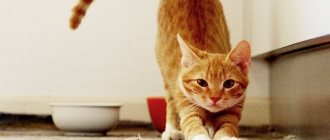How old is your pet?
Ten? More? Then this is definitely the place for you! Because after 8-10 years, various age-related changes begin to occur in the cat’s body, which you need to be aware of and take into account. May your four-legged pet live happily ever after! By the way, previously the age limit for our pets was much lower - 12-year-old cats were considered long-livers. It was man who raised the quality of life, and with it its duration, by one and a half to two times.
And now it is easy to meet cats that have reached 16-19 years of age, or even more. For example, in our clinic we see two cats, each 21 years old, and the most significant thing that worries them is their teeth, or rather, tartar, which is removed from them from time to time.
Well, the age of cats from the Guinness Book of Records generally exceeds the 30-year mark.
So, among pets, the number of “elderly” pets (approximately 30%) who need optimal care is increasing.
It’s a fact that as the number of years you live increases, everything changes (and not only for cats :-)). Age-related changes affect all body functions. For now, we will consider only behavioral ones.
The causes of behavioral changes can be a number of diseases (including systemic ones) acquired by the animal over the years of its life, brain pathologies, as well as CDS - cognitive dysfunction syndrome. First, let's look at medical ailments, and then move on to the most interesting part.
Osteoarthritis (joint disease) can occur in 65% of cats over 12 years of age (the elbow and hip joints are most commonly affected, and the knee and shoulder are less common). Joint pain leads to decreased mobility and the appearance of aggressiveness when communicating with people and other animals.
Systemic hypertension (high blood pressure) often causes a pet to scream at night, disorientate in space, lose consciousness, meaningless circular movements and even seizures.
Chronic kidney disease most strongly influences behavior changes: polyuria (increased urine volume) leads to urination in the wrong places, and with a lack of water, dehydration of brain tissue. Polydipsia (increased thirst) causes cats to drink from containers that are not intended for this purpose. The development of acidosis (increased body acidity) causes weight loss and drowsiness. And severe uremia (self-poisoning of the body with nitrogenous waste from urine) leads to uremic encephalopathy, a non-inflammatory disease of the brain. In addition, kidney disease is often accompanied by hypertension (see above).
Hyperthyroidism (increased thyroid hormones) leads to the same consequences as chronic renal failure. In addition, it affects the concentration of thyroxine in the brain (manifests as anxiety and aggressiveness), causes polyphagia - the cat’s taste and appetite change.
Diabetes mellitus has the same consequences as chronic renal failure and hyperthyroidism. In addition, it can cause sensory or motor neuropathies (irritability, increased sensitivity to external influences (touch), muscle pain).
Urinary tract infections cause pain and discomfort in your pet's bladder or kidneys. The result is “incorrect” urination, anxiety, aggression, and depression.
Changes in appetite, weight loss, gastrointestinal diseases , which appear due to physiological changes and pathological processes, are associated with a deterioration in the sense of smell and taste, pain in the oral cavity, for example, due to periodontal disease.
Loss of Hearing and Vision Cats quickly adapt to blindness. With deafness the situation is worse. Cats with poor hearing begin to make loud noises (possibly at night) because they have difficulty hearing their voices.
Brain tumors are more common in older cats (11 years of age and up). Meningioma, lymphoma, glioma, pituitary tumors are expressed by restlessness, circular movements and convulsions.
Pain , especially constant pain, greatly debilitates the animal. Chronic pain most often occurs with artiritis, as well as with inflammatory processes in other organs, for example, with periodontal disease and diseases of the digestive tract (obstruction). Cats, due to their evolutionary development, are able to cope even with severe pain.
Infectious diseases (viral immunodeficiency, viral leukemia, infectious peritonitis, toxoplasmosis) cause neurological disorders and, consequently, behavioral changes.
So, there are many medical reasons for behavioral problems in older cats. And identifying them often requires a number of diagnostic studies. But if diseases are excluded, that is, when there is no obvious cause, then it is believed that the animal’s behavior changes under the influence of cognitive dysfunction syndrome (CDS)
Alzheimer's? In cats?!
Yeah, something like that. Everything is like the big ones.
In cats with cognitive dysfunction syndrome, changes occur in the brain that lead to decreased mental abilities. This affects the processes of thinking, memory, learning new things, and using acquired skills.
Cognitive dysfunction syndrome is a progressive disease with increasing signs of aging behavior
A third of 11-14 year old cats have at least one of the behavioral disorders caused by CDS, and in 15 year old cats the number of such problems is no less than 50%.
The most striking symptom of cognitive dysfunction is disorientation. The cat seems to get lost in the apartment, hides in a corner or under furniture, bumps into door frames in an attempt to find the door, does not recognize the owners or other animals, and does not respond to calls.
The sleep-wake pattern is often disrupted (as a rule, the cat sleeps more during the day and much less at night).
The proportion of purposeful actions decreases and the frequency of aimless wandering increases. There may be movements in a circle or involuntary oscillatory movements - tremor, or, conversely, immobility, weakness.
An older cat may go potty less often and go to inappropriate places more often.
The quality of communication with the owners deteriorates, the animal asks for less and less affection and attention.
Where does SKD come from?
Possible reasons:
- disturbance of cerebral blood supply - a change in the circulatory system of the brain due to hypoxia caused by heart disease, hypertension, anemia, impaired blood clotting, the formation of small hemorrhages near blood vessels, arteriosclerosis
- tissue damage from free radicals As cells age, they process nutrients less and less well, the amount of energy decreases, and the number of free radicals in the cells increases, which the body’s antioxidant defense does not have time to neutralize. An excess of these radicals leads to tissue damage, with brain tissue being especially sensitive.
Quirks of an old cat, or Aged pets
Somehow my cat Mukha has aged imperceptibly. I figured she was about 17 years old. Mucha began to ask to be held more often, and in her meows, finicky notes began to be constantly heard, like: “Give way the chair!”, or “Don’t touch me!”
